Baby Wipes Market
Baby Wipes Market Size and Share Forecast Outlook 2025 to 2035
The baby wipes market is projected to grow from USD 6.2 billion in 2025 to USD 9.1 billion by 2035, at a CAGR of 3.9%. Wet Wipes will dominate with a 86.0% market share, while nonwoven spunlace will lead the material segment with a 72.0% share.
Baby Wipes Market Analysis - Size, Share, and Forecast Outlook 2025 to 2035
The global baby wipes market is projected to reach USD 9.1 billion by 2035, recording an absolute increase of USD 2.9 billion over the forecast period. The market is valued at USD 6.2 billion in 2025 and is set to rise at a CAGR of 3.9% during the assessment period.
The market is expected to grow by nearly 1.5 times during the same period, supported by increasing birth rates in developing regions and rising awareness of infant hygiene worldwide, driving demand for convenient baby care products and growing adoption of premium and natural wipe formulations globally. However, environmental concerns regarding disposable products and economic pressures affecting family spending may pose challenges to market expansion.
Quick Stats for Baby Wipes Market
- Baby Wipes Market Value (2025): USD 6.2 billion
- Baby Wipes Market Forecast Value (2035): USD 9.1 billion
- Baby Wipes Market Forecast CAGR: 3.9%
- Leading Type in Baby Wipes Market: Wet Wipes
- Key Growth Regions in Baby Wipes Market: Asia-Pacific, North America, and Europe
- Top Key Players in Baby Wipes Market: Procter & Gamble, Kimberly-Clark, Unicharm, Essity, Johnson & Johnson, Huggies, WaterWipes, Nice-Pak, Edgewell, Ontex
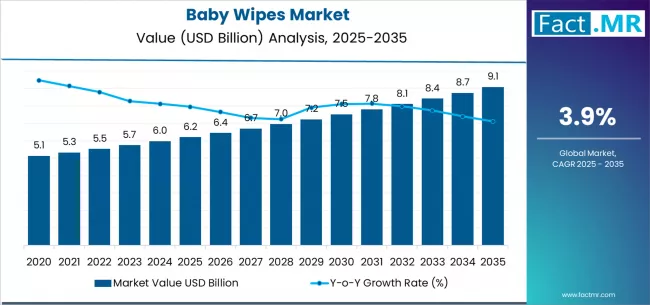
Between 2025 and 2030, the baby wipes market is projected to expand from USD 6.2 billion to USD 7.6 billion, resulting in a value increase of USD 1.4 billion, which represents 48.3% of the total forecast growth for the decade.
This phase of development will be shaped by rising birth rates in emerging markets and increasing parental awareness of infant hygiene, product innovation in natural and sensitive skin formulations and sustainable packaging solutions, as well as expanding integration with e-commerce platforms and subscription-based delivery services.
Companies are establishing competitive positions through investment in premium formulations, eco-friendly materials, and strategic market expansion across retail, online, and pharmacy channels.
From 2030 to 2035, the market is forecast to grow from USD 7.6 billion to USD 9.1 billion, adding another USD 1.5 billion, which constitutes 51.7% of the overall ten-year expansion. This period is expected to be characterized by the expansion of natural and organic baby wipe products, including biodegradable materials and plant-based formulations tailored for environmentally conscious parents, strategic collaborations between baby care brands and sustainability organizations, and an enhanced focus on skin health and dermatological testing.
The growing emphasis on natural baby care and environmental responsibility will drive demand for comprehensive baby wipe solutions across diverse retail, e-commerce, and healthcare applications.
Baby Wipes Market Key Takeaways
| Metric | Value |
|---|---|
| Market Value (2025) | USD 6.2 billion |
| Market Forecast Value (2035) | USD 9.1 billion |
| Forecast CAGR (2025-2035) | 3.9% |
Why is the Baby Wipes Market Growing?
The baby wipes market grows by enabling parents and caregivers to access convenient infant hygiene solutions and portable cleaning products that deliver superior cleansing and skin care benefits without requiring water or additional cleaning supplies.
New parents and childcare professionals face increasing demands for convenient, safe, and effective baby care products, with premium baby wipes typically providing gentle cleansing, moisturizing properties, and portability that traditional cloth and water cleaning cannot match for on-the-go infant care, making quality baby wipes essential for modern parenting and professional childcare positioning.
The baby care industry's need for convenient and skin-safe products creates demand for comprehensive wipe solutions that can provide effective cleansing, maintain skin health, and ensure parental confidence without compromising infant safety or care quality.
Government initiatives promoting infant health and maternal support drive adoption in developing regions where improved access to baby care products directly impacts infant hygiene standards and parental convenience. However, environmental concerns regarding disposable product waste and economic pressures affecting household baby care spending may limit premium product adoption among environmentally conscious families and price-sensitive market segments.
Segmental Analysis
The market is segmented by type, material, distribution channel, and region. By type, the market is divided into wet wipes and dry wipes. Based on material, the market is categorized into nonwoven spunlace, airlaid, others. By distribution channel, the market includes modern trade, online, pharmacies. Regionally, the market is divided into Asia-Pacific, North America, Europe, and other key regions.
By Type, the Wet Wipes Segment Accounts for a Dominant Market Share
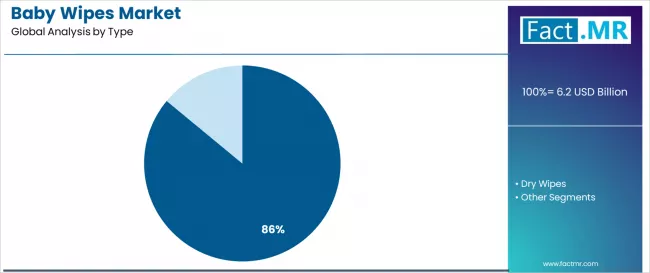
The wet wipes segment represents the dominant force in the baby wipes market, capturing approximately 86.0% of total market share in 2025. Wet wipes encompass pre-moistened cleaning wipes featuring gentle cleansing formulations, convenient packaging, and ready-to-use functionality that enable immediate infant hygiene care without additional preparation or supplies.
The wet wipes segment's market leadership stems from its superior convenience capabilities, with products capable of providing effective cleansing while maintaining skin moisturization and portability across all parenting and childcare environments.
The dry wipes segment maintains a substantial 13.9% market share, serving cost-conscious parents and environmentally aware families who require reusable cleaning options with water addition flexibility for customized cleaning solutions and reduced packaging waste. These products offer economical baby care solutions for budget-focused families while providing sufficient cleaning capability when combined with water or preferred cleansing solutions.
Key type advantages driving the wet wipes segment include:
- Ready-to-use convenience with pre-moistened formulations that eliminate preparation time and ensure consistent cleansing performance for busy parents
- Gentle cleansing solutions with pH-balanced formulations that maintain infant skin health and prevent irritation during frequent use
- Portable packaging options allowing on-the-go baby care without additional supplies or cleaning preparation requirements
- Moisturizing benefits features, supporting infant skin health and preventing dryness during regular diaper changes and cleaning routines
By Material, the Nonwoven Spunlace Segment Accounts for the Largest Market Share
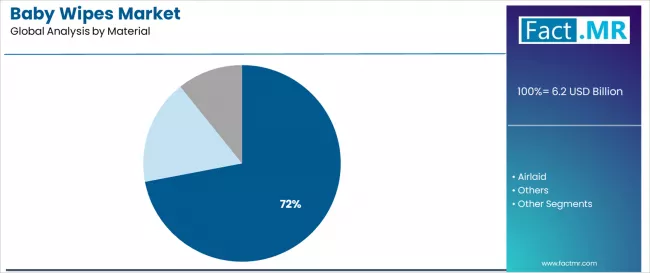
Nonwoven spunlace materials dominate the baby wipes market with approximately 72.0% market share in 2025, reflecting the preferred material choice for premium baby wipes manufacturing due to superior softness, strength, and fluid retention properties that ensure gentle skin contact and effective cleaning performance. The nonwoven spunlace segment's market leadership is reinforced by material properties that provide optimal balance between durability and gentleness for sensitive infant skin applications.
The airlaid segment represents the second-largest material category, capturing 18.0% market share through enhanced absorbency characteristics, natural fiber integration, and premium positioning for sensitive skin applications that require maximum gentleness and superior fluid handling. This segment benefits from growing demand for ultra-gentle baby care products that meet specific dermatological requirements and premium positioning standards.
The others segment accounts for 10.0% market share, serving specialized applications and emerging sustainable material innovations. This segment demonstrates growth through environmental positioning, biodegradable alternatives, and innovative material development.
Key market dynamics supporting material growth include:
- Nonwoven spunlace expansion driven by optimal balance of softness, strength, and manufacturing efficiency for mass market baby wipe production
- Airlaid specialization enabling premium positioning for sensitive skin applications with enhanced absorbency and natural fiber integration
- Material innovation creating sustainable alternatives and specialized applications for environmentally conscious consumer segments
- Growing emphasis on skin-safe materials driving demand for dermatologically tested and hypoallergenic baby wipe solutions
What are the Drivers, Restraints, and Key Trends of the Baby Wipes Market?
Urbanization and busy lifestyle trends create expanding demand for convenient baby care products, with working parent demographics growing by 3-5% annually in major developed countries worldwide, requiring comprehensive portable infant care solutions.
Infant hygiene awareness and pediatric recommendations drive increased adoption of specialized baby cleaning products, with many healthcare professionals endorsing gentle wipe formulations and regular infant cleaning practices by 2030.
E-commerce growth and subscription services enable expanded baby care product accessibility that supports consistent product usage while maintaining convenience and cost-effectiveness for busy families.
Market restraints include environmental concerns regarding disposable wipe waste that can influence eco-conscious parents toward reusable alternatives, particularly in regions with strong environmental awareness and sustainability education.
Economic pressures affecting household discretionary spending pose another significant challenge, as premium baby care products face reduced adoption during periods of financial constraint when families prioritize essential expenditures. Competition from alternative baby cleaning methods creates additional market pressure, demanding ongoing investment in convenience positioning and product differentiation.
Key trends indicate accelerated growth in natural and organic baby wipe products, particularly in North America and Europe, where clean-label preferences and chemical-free baby care drive comprehensive natural product adoption.
Technology integration trends toward plant-based materials with biodegradable properties, subscription delivery services, and dermatologist-tested formulations enable superior safety positioning that meets evolving parental health standards and environmental consciousness.
However, the market thesis could face disruption if environmental regulations significantly restrict disposable product manufacturing or economic pressures fundamentally alter baby care spending priorities.
Analysis of the Baby Wipes Market by Key Country
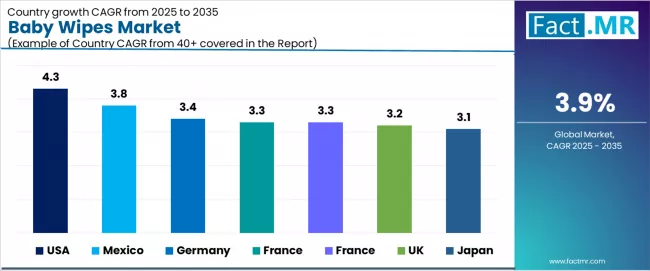
| Country | CAGR (2025-2035) |
|---|---|
| USA | 4.3% |
| Mexico | 3.8% |
| Germany | 3.4% |
| France | 3.3% |
| South Korea | 3.3% |
| UK | 3.2% |
| Japan | 3.1% |
The baby wipes market is gaining momentum worldwide, with the USA taking the lead thanks to strong parenting consumer culture and established baby care retail infrastructure. Close behind, Mexico benefits from rising birth rates and expanding middle-class baby care spending, positioning itself as a strategic growth hub in the Latin American region. Germany shows steady advancement, where integration of premium baby care trends strengthens its role in the European infant hygiene supply chain.
France and South Korea demonstrate equal growth momentum, focusing on natural baby care applications and premium product innovations, signaling ambitions to capitalize on the growing opportunities in infant care markets.
The UK stands out for its premium baby care culture and natural product preferences, and Japan continues to record consistent progress in baby care sophistication and product innovation. Together, the USA and Mexico anchor the global expansion story, while the rest build stability and diversity into the market's growth path.
The report covers an in-depth analysis of 40+ countries; 7 top-performing countries are highlighted below.
USA Leads Global Market Expansion
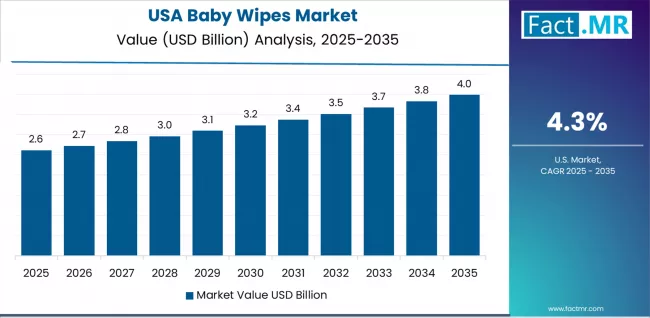
The USA demonstrates the strongest growth potential in the Baby Wipes Market with a CAGR of 4.3% through 2035. The country's leadership position stems from robust parenting consumer culture, established baby care retail infrastructure, and strong awareness of infant hygiene importance driving the adoption of premium baby wipe formulations and natural product options.
Growth is concentrated in major metropolitan areas, including New York, Los Angeles, Chicago, and Atlanta, where health-conscious parents and childcare professionals are implementing comprehensive infant hygiene routines and premium baby care products for enhanced child health outcomes.
Distribution channels through major retail chains and e-commerce platforms expand coverage across diverse parenting demographics and income levels throughout the country. The country's emphasis on child health and parenting convenience provides sustained demand for baby wipe innovation, including natural formulations and sustainable packaging.
Key market factors:
- Parenting culture expansion concentrated in metropolitan areas and suburban family markets with comprehensive baby care retail infrastructure development programs
- Child health consciousness through established pediatric care culture and premium baby product adoption patterns
- Comprehensive baby care ecosystem, including established retailers and specialized baby care brands
- Innovation leadership featuring natural formulations, sustainable packaging programs, and premium baby wipe safety capabilities
Mexico Emerges as High-Growth Market
In Mexico City, Guadalajara, Monterrey, and expanding urban family centers, the adoption of comprehensive baby wipe products is accelerating across growing middle-class families and increasing birth rate demographics, driven by economic development and rising awareness of infant hygiene importance. The market demonstrates strong growth momentum with a CAGR of 3.8% through 2035, linked to comprehensive urbanization and increasing focus on modern parenting practices and baby care product adoption.
Parents in Mexico are implementing baby wipe usage in daily infant care routines to enhance child hygiene while meeting growing health expectations in expanding urban family environments. The country's demographic advantages and family-focused culture create sustained demand for baby care products, while increasing emphasis on child health drives adoption of convenient and effective infant hygiene solutions.
- Leading urban family centers, including Mexico City, Guadalajara, and Monterrey, are driving baby wipe product adoption
- Family demographic models enabling middle-class expansion and modern parenting practice adoption
- Economic development trends accelerating adoption with established baby care retail expansion and family spending growth
- Cultural advantages through strong family values and increasing child health awareness among young parents
Germany Maintains Premium Baby Care Leadership
Germany's established premium baby care and child health sector demonstrates sophisticated implementation of baby wipe products, with documented case studies showing 22% increase in natural baby care product adoption through specialized baby retailers and premium baby care chains.
The country's premium baby care infrastructure in major cities, including Berlin, Munich, Hamburg, and Frankfurt, showcases integration of traditional German quality standards with modern child health technologies, leveraging expertise in product safety and premium baby care development.
End users in Germany emphasize safety, quality, and environmental responsibility, creating demand for certified organic baby wipe products that support child health goals and environmental consciousness. The market maintains steady growth through focus on safety innovation and premium quality standards, with a CAGR of 3.4% through 2035.
Key development areas:
- Premium baby care retailers and organic baby product chains leading natural baby wipe adoption with comprehensive safety assurance programs
- Child safety channels providing integrated solutions with 89% dermatologist-tested certification rates
- Innovation partnerships between German baby care companies and natural ingredient producers expanding premium market reach
- Integration of traditional German safety standards and modern natural baby care environmental responsibility
Europe Market Split by Country
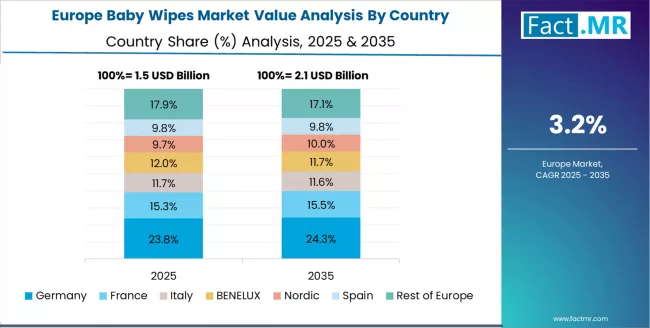
The baby wipes market in Europe is projected to grow from USD 1.55 billion in 2025 to USD 2.27 billion by 2035, registering a CAGR of 3.9% over the forecast period. Germany is expected to maintain its leadership position with a 24.5% market share in 2025, declining slightly to 24.3% by 2035, supported by its strong premium baby care infrastructure, established child safety culture, and comprehensive natural baby product distribution networks serving major European markets.
France follows with a 21.9% share in 2025, projected to reach 22.0% by 2035, driven by comprehensive natural baby care modernization programs in Paris, Lyon, and other metropolitan areas implementing advanced organic baby product retail experiences. The United Kingdom holds a 19.4% share in 2025, expected to maintain 19.2% by 2035 through the ongoing development of premium baby care and natural product applications.
Italy commands a 16.1% share, while Spain accounts for 12.9% in 2025. The Rest of Europe region is anticipated to gain momentum, expanding its collective share from 5.2% to 5.8% by 2035, attributed to increasing baby wipe adoption in Nordic countries and emerging Eastern European family markets implementing modern baby care standards.
Competitive Landscape of the Baby Wipes Market
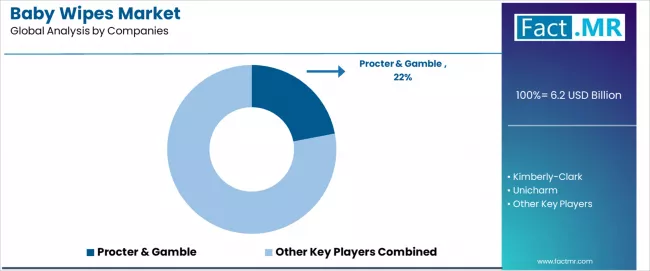
The baby wipes market features approximately 20-30 meaningful players with moderate concentration, where the top three companies control roughly 35-42% of global market share through established baby care brand portfolios and extensive retail distribution networks. Competition centers on safety assurance, gentle formulations, and trusted brand positioning rather than price competition alone.
Market leaders include Procter & Gamble, Kimberly-Clark, and Unicharm, which maintain competitive advantages through comprehensive baby care product portfolios, established parent trust relationships, and deep expertise in infant skin care formulations and safety testing, creating strong brand loyalty and pediatric endorsement capabilities. These companies leverage established global baby care networks and ongoing safety research investments to defend market positions while expanding into adjacent natural baby care categories and premium formulation segments.
Challengers encompass Essity and Johnson & Johnson, which compete through specialized baby care heritage and strong presence in key healthcare and family markets. Baby care and hygiene specialists, including Huggies, WaterWipes, and Nice-Pak, focus on specific formulation innovations or natural positioning, offering differentiated capabilities in sensitive skin care, water-based formulations, and premium baby care positioning.
Regional players and emerging natural baby care brands create competitive pressure through organic positioning and specialized formulations, particularly in high-growth markets including Asia-Pacific where natural baby care trends and premium parenting provide advantages in health-conscious positioning and safety verification.
Market dynamics favor companies that combine established safety records with comprehensive dermatological testing and trusted baby care relationships that address the complete infant hygiene lifecycle from newborn care through toddler development.
Global Baby Wipes Market - Stakeholder Contribution Framework
Baby wipe solutions represent a critical infant care product that enables parents, caregivers, and childcare professionals to access convenient hygiene solutions and gentle cleaning capabilities without water requirements or additional cleaning preparation, typically providing superior convenience, skin safety, and portability that traditional cloth cleaning cannot match for modern parenting needs.
With the market projected to grow from USD 6.2 billion in 2025 to USD 9.1 billion by 2035 at a 3.9% CAGR, these solutions offer compelling advantages - convenience, safety, and effectiveness - making them essential for daily infant care routines, on-the-go cleaning needs, and professional childcare applications seeking reliable infant hygiene solutions.
Scaling market penetration and environmental responsibility requires coordinated action across baby care industry policy, child safety standards, baby wipe manufacturers, retail partners, and environmental sustainability organizations.
How Governments Could Spur Local Production and Adoption?
- Child Health Programs: Include infant hygiene products in national child health initiatives, providing targeted support for baby care manufacturing and supporting family access to safe infant hygiene products through healthcare financing and parental education grants.
- Family Support & Safety Policy: Implement favorable treatment for child-safe product manufacturing, provide incentives for companies investing in dermatological testing and natural formulations, and establish safety standards that encourage infant-safe product adoption over potentially harmful alternatives.
- Regulatory Framework Development: Create standardized safety verification processes across baby care and infant hygiene applications, establish clear child safety certification frameworks for international trade, and develop dermatological testing protocols that facilitate safe baby product commerce.
- Child Safety & Education: Fund parental education programs on infant hygiene practices, child safety product selection, and safe baby care routines. Invest in healthcare initiatives that bridge traditional baby care practices with modern safety standards and pediatric recommendations.
- Market Access & Child Welfare: Establish procurement policies that support child-safe product manufacturing for government childcare applications, assist families through subsidized baby care programs, and create regulatory environments that encourage innovation in safe baby care while protecting infant health.
How Industry Bodies Could Support Market Development?
- Child Safety Standards & Certification: Define standardized safety metrics for baby wipes across retail and healthcare applications, establish universal infant safety and dermatological protocols, and create certification programs for child-safe manufacturing practices that parents and pediatricians can trust.
- Market Education & Best Practices: Lead messaging that demonstrates baby wipe advantages, emphasizing convenience, safety, and infant skin health benefits compared to traditional cleaning alternatives.
- Safety Integration Standards: Develop interoperability standards for child safety certification, dermatological testing guidelines, and pediatric-approved platforms, ensuring seamless integration across different infant care applications and international child safety markets.
- Professional Development: Run certification programs for childcare specialists, pediatric professionals, and safety experts on optimizing baby wipe applications, safety verification, and infant hygiene practices in competitive baby care markets.
How Manufacturers and Technology Players Could Strengthen the Ecosystem?
- Advanced Formulation Development: Develop next-generation baby wipe formulations with enhanced skin safety capabilities, improved natural ingredient profiles, and sustainable materials that maintain convenience while enabling superior infant skin care and reduced environmental impact.
- Safety Platforms: Provide comprehensive traceability systems that integrate blockchain verification, ingredient sourcing transparency, safety monitoring, and dermatological testing assurance, enabling baby care brands to maximize ingredient transparency and child safety authenticity.
- Service & Support Networks: Offer flexible support programs for parents and childcare providers, including safety verification options, pediatric consultation services, and infant care guidance that keep baby wipe products current with child health standards and parental expectations.
- Research & Development Networks: Build comprehensive R&D capabilities, collaborative child safety programs, and dermatological testing systems that ensure baby wipe technologies maintain superior infant safety and consistent skin health benefits across diverse infant care applications.
How Suppliers Could Navigate the Shift?
- Diversified Safety Portfolios: Expand baby wipe offerings across wet wipes (86.0% market dominance), specialized formulations, and material innovations, with particular focus on modern trade channels (43.9% channel share) and natural ingredient positioning strategies.
- Geographic Market Development: Establish operations in high-growth markets like USA (4.3% CAGR) and Mexico (3.8% CAGR), while strengthening presence in established markets like Germany (3.4% CAGR) and France (3.3% CAGR) through regional partnerships and local child safety understanding.
- Technology-Enabled Services: Implement advanced safety tracking systems with dermatological verification, ingredient transparency, and child safety monitoring capabilities that differentiate service offerings and improve parent and childcare provider satisfaction.
- Flexible Safety Models: Develop wet, natural, and premium baby wipe solutions that accommodate varying family needs, from cost-effective daily care to ultra-premium sensitive skin products for demanding infant safety requirements.
How Investors and Financial Enablers Could Unlock Value?
- Baby Care Expansion Financing: Provide growth capital for established companies like Procter & Gamble, Kimberly-Clark, and Unicharm to expand natural formulation capabilities and sustainable packaging, particularly in emerging markets with growing birth rates and parenting awareness.
- Innovation Investment: Back startups developing advanced natural baby care technologies, sustainable packaging platforms, and dermatological testing systems that enhance baby wipe industry innovation and competitive positioning.
- Regional Market Development: Finance market entry and expansion strategies for baby wipe companies establishing operations in high-growth regions, supporting family-focused partnerships that enhance safe product access while maintaining affordability.
- Consolidation & Scale Opportunities: Support strategic acquisitions and market consolidation that create economies of scale, improve child safety capabilities, and enhance competitive positioning against fragmented regional baby care providers across multiple geographic markets.
Key Players in the Baby Wipes Market
- Procter & Gamble
- Kimberly-Clark
- Unicharm
- Essity
- Johnson & Johnson
- Huggies
- WaterWipes
- Nice-Pak
- Edgewell
- Ontex
Scope of the Report
| Item | Value |
|---|---|
| Quantitative Units | USD 6.2 Billion |
| Type | Wet Wipes, Dry Wipes |
| Material | Nonwoven Spunlace, Airlaid, Others |
| Distribution Channel | Modern Trade, Online, Pharmacies |
| Regions Covered | Asia-Pacific, North America, Europe, Latin America, Middle East & Africa |
| Country Covered | USA, Mexico, Germany, France, South Korea, UK, Japan, and 40+ countries |
| Key Companies Profiled | Procter & Gamble, Kimberly-Clark, Unicharm, Essity, Johnson & Johnson, Huggies, WaterWipes, Nice-Pak, Edgewell, Ontex |
| Additional Attributes | Dollar sales by type and material categories, regional adoption trends across Asia-Pacific, North America, and Europe, competitive landscape with baby care manufacturers and retail partners, parenting behavior patterns and infant care preferences, integration with natural baby care trends and safety programs, innovations in formulation technology and sustainable packaging systems, and development of specialized applications with dermatological verification and child safety positioning. |
Baby Wipes Market by Segments
-
Type :
- Wet Wipes
- Dry Wipes
-
Material :
- Nonwoven Spunlace
- Airlaid
- Others
-
Distribution Channel :
- Modern Trade
- Online
- Pharmacies
-
Region :
- Asia-Pacific
- China
- Japan
- South Korea
- India
- Australia & New Zealand
- ASEAN
- Rest of Asia Pacific
- North America
- United States
- Canada
- Mexico
- Europe
- Germany
- United Kingdom
- France
- Italy
- Spain
- Nordic
- BENELUX
- Rest of Europe
- Latin America
- Brazil
- Chile
- Rest of Latin America
- Middle East & Africa
- Kingdom of Saudi Arabia
- Other GCC Countries
- Turkey
- South Africa
- Other African Union
- Rest of Middle East & Africa
- Asia-Pacific
Table of Content
- Executive Summary
- Global Market Outlook
- Demand to side Trends
- Supply to side Trends
- Technology Roadmap Analysis
- Analysis and Recommendations
- Market Overview
- Market Coverage / Taxonomy
- Market Definition / Scope / Limitations
- Market Background
- Market Dynamics
- Drivers
- Restraints
- Opportunity
- Trends
- Scenario Forecast
- Demand in Optimistic Scenario
- Demand in Likely Scenario
- Demand in Conservative Scenario
- Opportunity Map Analysis
- Product Life Cycle Analysis
- Supply Chain Analysis
- Investment Feasibility Matrix
- Value Chain Analysis
- PESTLE and Porter’s Analysis
- Regulatory Landscape
- Regional Parent Market Outlook
- Production and Consumption Statistics
- Import and Export Statistics
- Market Dynamics
- Global Market Analysis 2020 to 2024 and Forecast, 2025 to 2035
- Historical Market Size Value (USD Million) Analysis, 2020 to 2024
- Current and Future Market Size Value (USD Million) Projections, 2025 to 2035
- Y to o to Y Growth Trend Analysis
- Absolute $ Opportunity Analysis
- Global Market Pricing Analysis 2020 to 2024 and Forecast 2025 to 2035
- Global Market Analysis 2020 to 2024 and Forecast 2025 to 2035, By Type
- Introduction / Key Findings
- Historical Market Size Value (USD Million) Analysis By Type , 2020 to 2024
- Current and Future Market Size Value (USD Million) Analysis and Forecast By Type , 2025 to 2035
- Wet Wipes
- Dry Wipes
- Y to o to Y Growth Trend Analysis By Type , 2020 to 2024
- Absolute $ Opportunity Analysis By Type , 2025 to 2035
- Global Market Analysis 2020 to 2024 and Forecast 2025 to 2035, By Material
- Introduction / Key Findings
- Historical Market Size Value (USD Million) Analysis By Material, 2020 to 2024
- Current and Future Market Size Value (USD Million) Analysis and Forecast By Material, 2025 to 2035
- Nonwoven Spunlace
- Airlaid
- Others
- Y to o to Y Growth Trend Analysis By Material, 2020 to 2024
- Absolute $ Opportunity Analysis By Material, 2025 to 2035
- Global Market Analysis 2020 to 2024 and Forecast 2025 to 2035, By Region
- Introduction
- Historical Market Size Value (USD Million) Analysis By Region, 2020 to 2024
- Current Market Size Value (USD Million) Analysis and Forecast By Region, 2025 to 2035
- North America
- Latin America
- Western Europe
- Eastern Europe
- East Asia
- South Asia and Pacific
- Middle East & Africa
- Market Attractiveness Analysis By Region
- North America Market Analysis 2020 to 2024 and Forecast 2025 to 2035, By Country
- Historical Market Size Value (USD Million) Trend Analysis By Market Taxonomy, 2020 to 2024
- Market Size Value (USD Million) Forecast By Market Taxonomy, 2025 to 2035
- By Country
- USA
- Canada
- Mexico
- By Type
- By Material
- By Country
- Market Attractiveness Analysis
- By Country
- By Type
- By Material
- Key Takeaways
- Latin America Market Analysis 2020 to 2024 and Forecast 2025 to 2035, By Country
- Historical Market Size Value (USD Million) Trend Analysis By Market Taxonomy, 2020 to 2024
- Market Size Value (USD Million) Forecast By Market Taxonomy, 2025 to 2035
- By Country
- Brazil
- Chile
- Rest of Latin America
- By Type
- By Material
- By Country
- Market Attractiveness Analysis
- By Country
- By Type
- By Material
- Key Takeaways
- Western Europe Market Analysis 2020 to 2024 and Forecast 2025 to 2035, By Country
- Historical Market Size Value (USD Million) Trend Analysis By Market Taxonomy, 2020 to 2024
- Market Size Value (USD Million) Forecast By Market Taxonomy, 2025 to 2035
- By Country
- Germany
- UK
- Italy
- Spain
- France
- Nordic
- BENELUX
- Rest of Western Europe
- By Type
- By Material
- By Country
- Market Attractiveness Analysis
- By Country
- By Type
- By Material
- Key Takeaways
- Eastern Europe Market Analysis 2020 to 2024 and Forecast 2025 to 2035, By Country
- Historical Market Size Value (USD Million) Trend Analysis By Market Taxonomy, 2020 to 2024
- Market Size Value (USD Million) Forecast By Market Taxonomy, 2025 to 2035
- By Country
- Russia
- Poland
- Hungary
- Balkan & Baltic
- Rest of Eastern Europe
- By Type
- By Material
- By Country
- Market Attractiveness Analysis
- By Country
- By Type
- By Material
- Key Takeaways
- East Asia Market Analysis 2020 to 2024 and Forecast 2025 to 2035, By Country
- Historical Market Size Value (USD Million) Trend Analysis By Market Taxonomy, 2020 to 2024
- Market Size Value (USD Million) Forecast By Market Taxonomy, 2025 to 2035
- By Country
- China
- Japan
- South Korea
- By Type
- By Material
- By Country
- Market Attractiveness Analysis
- By Country
- By Type
- By Material
- Key Takeaways
- South Asia and Pacific Market Analysis 2020 to 2024 and Forecast 2025 to 2035, By Country
- Historical Market Size Value (USD Million) Trend Analysis By Market Taxonomy, 2020 to 2024
- Market Size Value (USD Million) Forecast By Market Taxonomy, 2025 to 2035
- By Country
- India
- ASEAN
- Australia & New Zealand
- Rest of South Asia and Pacific
- By Type
- By Material
- By Country
- Market Attractiveness Analysis
- By Country
- By Type
- By Material
- Key Takeaways
- Middle East & Africa Market Analysis 2020 to 2024 and Forecast 2025 to 2035, By Country
- Historical Market Size Value (USD Million) Trend Analysis By Market Taxonomy, 2020 to 2024
- Market Size Value (USD Million) Forecast By Market Taxonomy, 2025 to 2035
- By Country
- Kingdom of Saudi Arabia
- Other GCC Countries
- Turkiye
- South Africa
- Other African Union
- Rest of Middle East & Africa
- By Type
- By Material
- By Country
- Market Attractiveness Analysis
- By Country
- By Type
- By Material
- Key Takeaways
- Key Countries Market Analysis
- USA
- Pricing Analysis
- Market Share Analysis, 2024
- By Type
- By Material
- Canada
- Pricing Analysis
- Market Share Analysis, 2024
- By Type
- By Material
- Mexico
- Pricing Analysis
- Market Share Analysis, 2024
- By Type
- By Material
- Brazil
- Pricing Analysis
- Market Share Analysis, 2024
- By Type
- By Material
- Chile
- Pricing Analysis
- Market Share Analysis, 2024
- By Type
- By Material
- Germany
- Pricing Analysis
- Market Share Analysis, 2024
- By Type
- By Material
- UK
- Pricing Analysis
- Market Share Analysis, 2024
- By Type
- By Material
- Italy
- Pricing Analysis
- Market Share Analysis, 2024
- By Type
- By Material
- Spain
- Pricing Analysis
- Market Share Analysis, 2024
- By Type
- By Material
- France
- Pricing Analysis
- Market Share Analysis, 2024
- By Type
- By Material
- India
- Pricing Analysis
- Market Share Analysis, 2024
- By Type
- By Material
- ASEAN
- Pricing Analysis
- Market Share Analysis, 2024
- By Type
- By Material
- Australia & New Zealand
- Pricing Analysis
- Market Share Analysis, 2024
- By Type
- By Material
- China
- Pricing Analysis
- Market Share Analysis, 2024
- By Type
- By Material
- Japan
- Pricing Analysis
- Market Share Analysis, 2024
- By Type
- By Material
- South Korea
- Pricing Analysis
- Market Share Analysis, 2024
- By Type
- By Material
- Russia
- Pricing Analysis
- Market Share Analysis, 2024
- By Type
- By Material
- Poland
- Pricing Analysis
- Market Share Analysis, 2024
- By Type
- By Material
- Hungary
- Pricing Analysis
- Market Share Analysis, 2024
- By Type
- By Material
- Kingdom of Saudi Arabia
- Pricing Analysis
- Market Share Analysis, 2024
- By Type
- By Material
- Turkiye
- Pricing Analysis
- Market Share Analysis, 2024
- By Type
- By Material
- South Africa
- Pricing Analysis
- Market Share Analysis, 2024
- By Type
- By Material
- USA
- Market Structure Analysis
- Competition Dashboard
- Competition Benchmarking
- Market Share Analysis of Top Players
- By Regional
- By Type
- By Material
- Competition Analysis
- Competition Deep Dive
- Procter & Gamble
- Overview
- Product Portfolio
- Profitability by Market Segments (Product/Age /Sales Channel/Region)
- Sales Footprint
- Strategy Overview
- Marketing Strategy
- Product Strategy
- Channel Strategy
- Kimberly-Clark
- Unicharm
- Essity
- Johnson & Johnson
- Huggies
- WaterWipes
- Nice-Pak
- Edgewell
- Ontex
- Procter & Gamble
- Competition Deep Dive
- Assumptions & Acronyms Used
- Research Methodology
List Of Table
- Table 1: Global Market Value (USD Million) Forecast by Region, 2020 to 2035
- Table 2: Global Market Value (USD Million) Forecast by Type , 2020 to 2035
- Table 3: Global Market Value (USD Million) Forecast by Material, 2020 to 2035
- Table 4: North America Market Value (USD Million) Forecast by Country, 2020 to 2035
- Table 5: North America Market Value (USD Million) Forecast by Type , 2020 to 2035
- Table 6: North America Market Value (USD Million) Forecast by Material, 2020 to 2035
- Table 7: Latin America Market Value (USD Million) Forecast by Country, 2020 to 2035
- Table 8: Latin America Market Value (USD Million) Forecast by Type , 2020 to 2035
- Table 9: Latin America Market Value (USD Million) Forecast by Material, 2020 to 2035
- Table 10: Western Europe Market Value (USD Million) Forecast by Country, 2020 to 2035
- Table 11: Western Europe Market Value (USD Million) Forecast by Type , 2020 to 2035
- Table 12: Western Europe Market Value (USD Million) Forecast by Material, 2020 to 2035
- Table 13: Eastern Europe Market Value (USD Million) Forecast by Country, 2020 to 2035
- Table 14: Eastern Europe Market Value (USD Million) Forecast by Type , 2020 to 2035
- Table 15: Eastern Europe Market Value (USD Million) Forecast by Material, 2020 to 2035
- Table 16: East Asia Market Value (USD Million) Forecast by Country, 2020 to 2035
- Table 17: East Asia Market Value (USD Million) Forecast by Type , 2020 to 2035
- Table 18: East Asia Market Value (USD Million) Forecast by Material, 2020 to 2035
- Table 19: South Asia and Pacific Market Value (USD Million) Forecast by Country, 2020 to 2035
- Table 20: South Asia and Pacific Market Value (USD Million) Forecast by Type , 2020 to 2035
- Table 21: South Asia and Pacific Market Value (USD Million) Forecast by Material, 2020 to 2035
- Table 22: Middle East & Africa Market Value (USD Million) Forecast by Country, 2020 to 2035
- Table 23: Middle East & Africa Market Value (USD Million) Forecast by Type , 2020 to 2035
- Table 24: Middle East & Africa Market Value (USD Million) Forecast by Material, 2020 to 2035
List Of Figures
- Figure 1: Global Market Pricing Analysis
- Figure 2: Global Market Value (USD Million) Forecast 2020-2035
- Figure 3: Global Market Value Share and BPS Analysis by Type , 2025 and 2035
- Figure 4: Global Market Y to o to Y Growth Comparison by Type , 2025-2035
- Figure 5: Global Market Attractiveness Analysis by Type
- Figure 6: Global Market Value Share and BPS Analysis by Material, 2025 and 2035
- Figure 7: Global Market Y to o to Y Growth Comparison by Material, 2025-2035
- Figure 8: Global Market Attractiveness Analysis by Material
- Figure 9: Global Market Value (USD Million) Share and BPS Analysis by Region, 2025 and 2035
- Figure 10: Global Market Y to o to Y Growth Comparison by Region, 2025-2035
- Figure 11: Global Market Attractiveness Analysis by Region
- Figure 12: North America Market Incremental Dollar Opportunity, 2025-2035
- Figure 13: Latin America Market Incremental Dollar Opportunity, 2025-2035
- Figure 14: Western Europe Market Incremental Dollar Opportunity, 2025-2035
- Figure 15: Eastern Europe Market Incremental Dollar Opportunity, 2025-2035
- Figure 16: East Asia Market Incremental Dollar Opportunity, 2025-2035
- Figure 17: South Asia and Pacific Market Incremental Dollar Opportunity, 2025-2035
- Figure 18: Middle East & Africa Market Incremental Dollar Opportunity, 2025-2035
- Figure 19: North America Market Value Share and BPS Analysis by Country, 2025 and 2035
- Figure 20: North America Market Value Share and BPS Analysis by Type , 2025 and 2035
- Figure 21: North America Market Y to o to Y Growth Comparison by Type , 2025-2035
- Figure 22: North America Market Attractiveness Analysis by Type
- Figure 23: North America Market Value Share and BPS Analysis by Material, 2025 and 2035
- Figure 24: North America Market Y to o to Y Growth Comparison by Material, 2025-2035
- Figure 25: North America Market Attractiveness Analysis by Material
- Figure 26: Latin America Market Value Share and BPS Analysis by Country, 2025 and 2035
- Figure 27: Latin America Market Value Share and BPS Analysis by Type , 2025 and 2035
- Figure 28: Latin America Market Y to o to Y Growth Comparison by Type , 2025-2035
- Figure 29: Latin America Market Attractiveness Analysis by Type
- Figure 30: Latin America Market Value Share and BPS Analysis by Material, 2025 and 2035
- Figure 31: Latin America Market Y to o to Y Growth Comparison by Material, 2025-2035
- Figure 32: Latin America Market Attractiveness Analysis by Material
- Figure 33: Western Europe Market Value Share and BPS Analysis by Country, 2025 and 2035
- Figure 34: Western Europe Market Value Share and BPS Analysis by Type , 2025 and 2035
- Figure 35: Western Europe Market Y to o to Y Growth Comparison by Type , 2025-2035
- Figure 36: Western Europe Market Attractiveness Analysis by Type
- Figure 37: Western Europe Market Value Share and BPS Analysis by Material, 2025 and 2035
- Figure 38: Western Europe Market Y to o to Y Growth Comparison by Material, 2025-2035
- Figure 39: Western Europe Market Attractiveness Analysis by Material
- Figure 40: Eastern Europe Market Value Share and BPS Analysis by Country, 2025 and 2035
- Figure 41: Eastern Europe Market Value Share and BPS Analysis by Type , 2025 and 2035
- Figure 42: Eastern Europe Market Y to o to Y Growth Comparison by Type , 2025-2035
- Figure 43: Eastern Europe Market Attractiveness Analysis by Type
- Figure 44: Eastern Europe Market Value Share and BPS Analysis by Material, 2025 and 2035
- Figure 45: Eastern Europe Market Y to o to Y Growth Comparison by Material, 2025-2035
- Figure 46: Eastern Europe Market Attractiveness Analysis by Material
- Figure 47: East Asia Market Value Share and BPS Analysis by Country, 2025 and 2035
- Figure 48: East Asia Market Value Share and BPS Analysis by Type , 2025 and 2035
- Figure 49: East Asia Market Y to o to Y Growth Comparison by Type , 2025-2035
- Figure 50: East Asia Market Attractiveness Analysis by Type
- Figure 51: East Asia Market Value Share and BPS Analysis by Material, 2025 and 2035
- Figure 52: East Asia Market Y to o to Y Growth Comparison by Material, 2025-2035
- Figure 53: East Asia Market Attractiveness Analysis by Material
- Figure 54: South Asia and Pacific Market Value Share and BPS Analysis by Country, 2025 and 2035
- Figure 55: South Asia and Pacific Market Value Share and BPS Analysis by Type , 2025 and 2035
- Figure 56: South Asia and Pacific Market Y to o to Y Growth Comparison by Type , 2025-2035
- Figure 57: South Asia and Pacific Market Attractiveness Analysis by Type
- Figure 58: South Asia and Pacific Market Value Share and BPS Analysis by Material, 2025 and 2035
- Figure 59: South Asia and Pacific Market Y to o to Y Growth Comparison by Material, 2025-2035
- Figure 60: South Asia and Pacific Market Attractiveness Analysis by Material
- Figure 61: Middle East & Africa Market Value Share and BPS Analysis by Country, 2025 and 2035
- Figure 62: Middle East & Africa Market Value Share and BPS Analysis by Type , 2025 and 2035
- Figure 63: Middle East & Africa Market Y to o to Y Growth Comparison by Type , 2025-2035
- Figure 64: Middle East & Africa Market Attractiveness Analysis by Type
- Figure 65: Middle East & Africa Market Value Share and BPS Analysis by Material, 2025 and 2035
- Figure 66: Middle East & Africa Market Y to o to Y Growth Comparison by Material, 2025-2035
- Figure 67: Middle East & Africa Market Attractiveness Analysis by Material
- Figure 68: Global Market - Tier Structure Analysis
- Figure 69: Global Market - Company Share Analysis
- FAQs -
How big is the baby wipes market in 2025?
The global baby wipes market is estimated to be valued at USD 6.2 billion in 2025.
What will be the size of baby wipes market in 2035?
The market size for the baby wipes market is projected to reach USD 9.1 billion by 2035.
How much will be the baby wipes market growth between 2025 and 2035?
The baby wipes market is expected to grow at a 3.9% CAGR between 2025 and 2035.
What are the key product types in the baby wipes market?
The key product types in baby wipes market are wet wipes and dry wipes.
Which material segment to contribute significant share in the baby wipes market in 2025?
In terms of material, nonwoven spunlace segment to command 72.0% share in the baby wipes market in 2025.